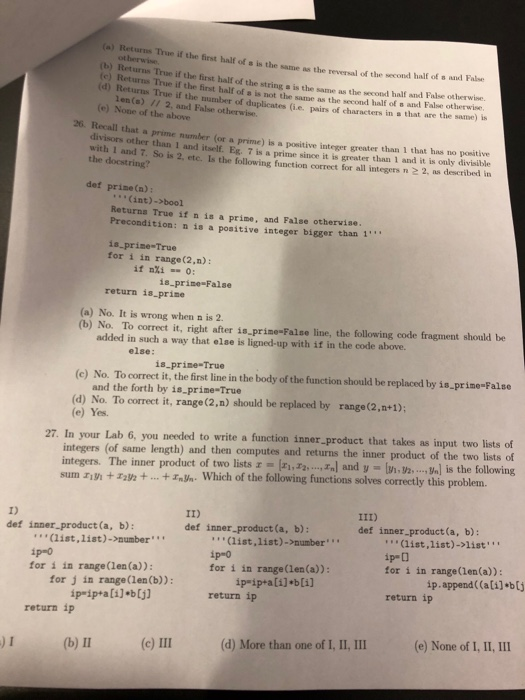(a) Returns True if the first half of a is the same as the reversal of the second half of s and False b) Returns True if the first half of the string a is the same as the second half and False ot herwise t) Returns True if the first half of a is not the same as the second half of s and False twi (d) Returns True if the number of len(a) 1 2, and False otherwise duplicates (i.e. pairs of characters in a that are the same) is (e) None of the above 26. Recall that a prime number (or a prime) is a positive integer greater than 1 that has no positive I and itself. Eg. 7 is a prime sinoe it is greater than 1 and it is only divisible 7. So is 2, ete. Is the following function correct for all integers n 2 2, as described in divisors other than with I and the docstring? def prime(a): "(int)->bool Returns True if n ia a prime, and False othervise. Precondition: n is a positive integer bigger than 1" isprine-True for i in range(2,n): isprine-False return is prine (a) No. It is wrong when n is 2. (b) No. To correct it, right after is.prine-False line, the following code fragment should be added in such a way that else is ligned-up with if in the code above. else is prine True (e) No. To correct it, the first line in the body of the function should be replaced by is.prime-False (e) ko To (e) Yes. and the forth by is.prime-True (d) No. To correct it, range (2,n) should be replaced by range (2,n+1); 27. In your Lab 6, you needed to write a function inner.product that takes as input two lists of integers (of same length) and then computes and returns the inner product of the two lists of wo listsz-Ir,22, , zal andy-y,h-.,Unl is the following sum in + t.+ Which of the following functions solves correctly this problem. I) def inner product (a, b): def inner product (a, b): def inner_product (a, b): (list,list)->number" ip O for i in range(len(a)): (list,list)->list" ip 0 for i in range(len(a)): (1ist,1ist)->number for i in range(len(a)): ip.append ((ati].bj ip-iprali].bli] for j in range(len (b)): return ip return ip return ip (d) More than one of I, II, III (e) None of I, II, I11 (b) II (c)







